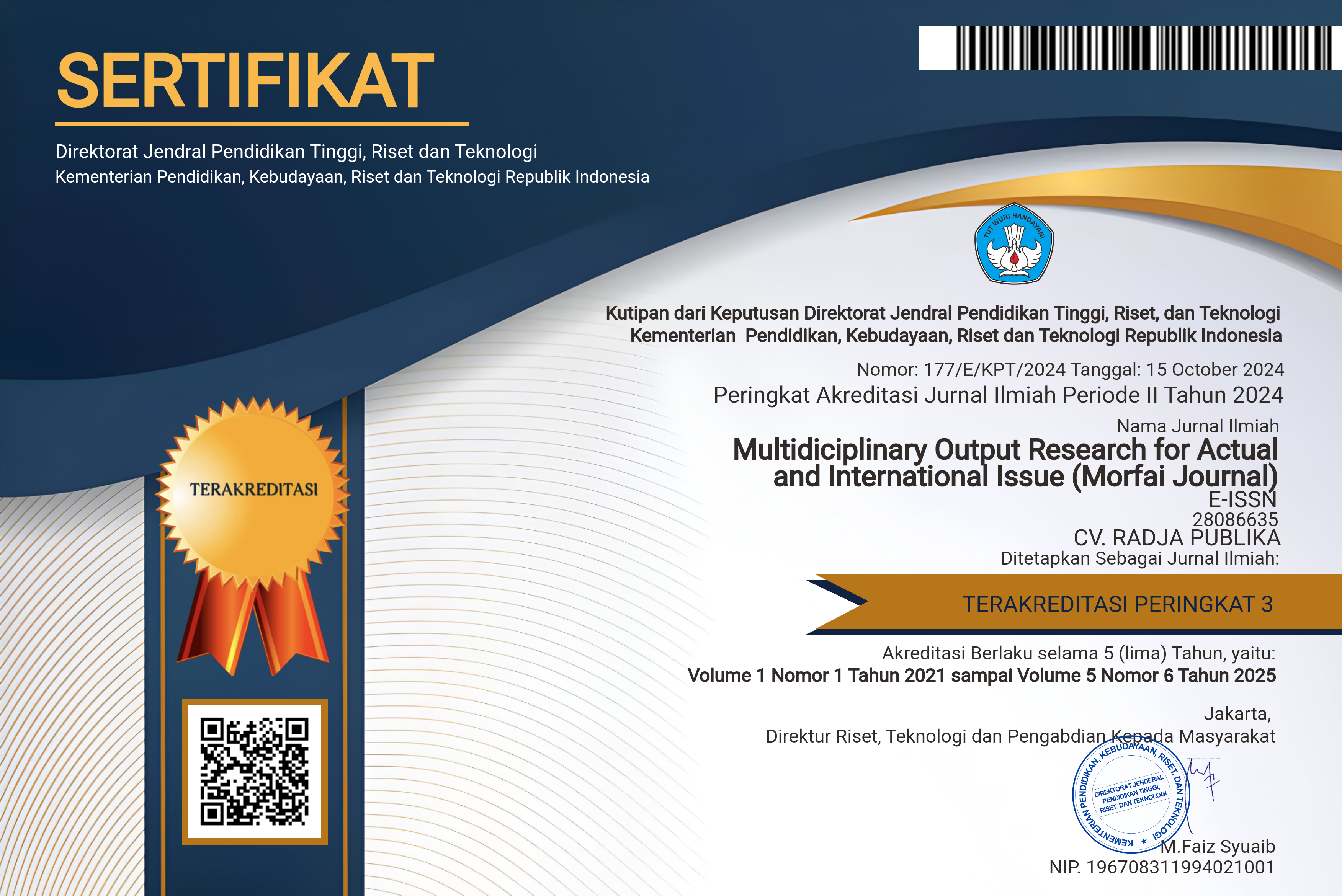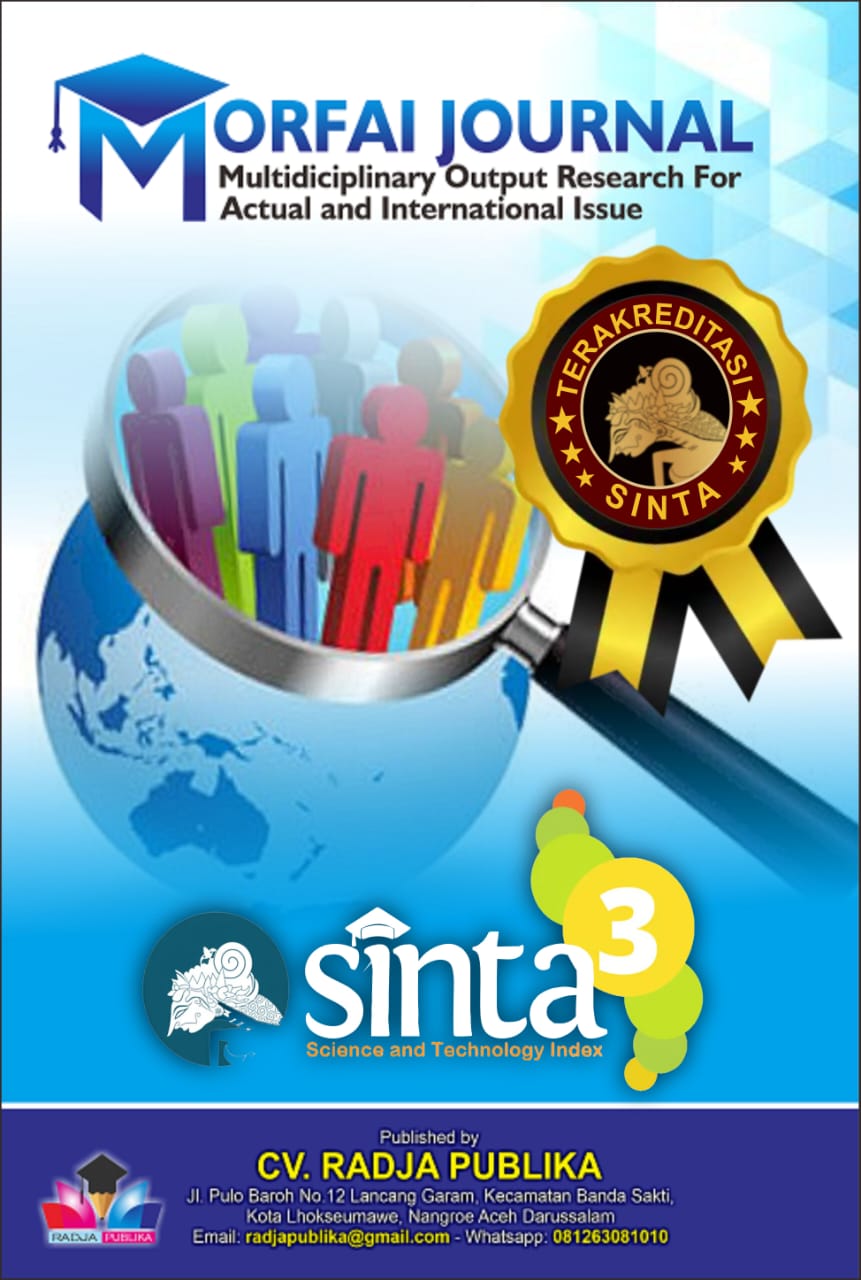RESILIENCE AND INNOVATION OF SMALL INDEPENDENT RETAILERS IN POST-COVID ECONOMIC RECOVERY IN EMERGING MARKET
Main Article Content
Irfan Saleh
Dina Dellyana
This study investigates how strategic planning, operational business practices, retailer supplier relationship, and technology adoption affect the performance of small independent retailers in Indonesia. By using Structural Equation Modeling (SEM) via SmartPLS, data were gathered from 283 retailers in Indonesia, West Java Province, specifically in Majalengka, Cirebon, Kuningan, and Indramayu between February and May 2025. Covid19 degraded the business sectors, the aim of study is to reveal how small independent retailer can survive and grow. The findings shows that both effective business operations and the use of technology significantly enhance customer loyalty, which is important in boosting retailer performance. Moreover, relationship among retailers and suppliers bridging the mediation effect of strategic planning on performance. Although strategic planning does not directly influence loyalty, its indirect effects highlight the importance of surrounding factors. The study reinforces the theoretical frameworks of the Technology to Performance Chain (TPC) and the relational view of firm performance, while proposing practical insights for retail strategy and digital innovation in emerging markets.
Mulyani, S. (2024, March 7). UMKM Indonesia Jadi Raja di Dunia, 97% Serap Tenaga Kerja. CNBC. https://www.cnbcindonesia.com/research/20240307154500-128-520473/umkm-indonesia-jadi-raja-di-dunia-97-serap-tenaga-kerja
Central Statistics Agency of Indonesia, (2020, December 21). Analisis Hasil Survei Dampak Covid-19 Terhadap Pelaku Usaha Jilid 2. www.bps.go.id. Analisis Hasil Survei Dampak Covid-19 Terhadap Pelaku Usaha Jilid 2 - Badan Pusat Statistik Indonesia
Runyan,R.C.,Droge,C.,2008.Acategorizationofsmallretailerresearchstreams: what doesitportendforfutureresearch?JournalofRetailing84,77–94.
Ramakrishnan, K.,2010.Thecompetitiveresponseofsmall,independentretailers to organizedretail:studyinanemergingeconomy.JournalofRetailingand Consumer Services17,251–258.
Praharsi, Y., Wee, H.-M., Sukwadi, R., & Padilan, M. V. (2014). Small-independent retailers vs. organized retailers: An empirical study in Indonesian economics of service industries. Journal of Retailing and Consumer Services, 21(2), 108-117. https://doi.org/10.1016/j.jretconser.2013.09.002
Vilà, J., & Canales, J. I. (2008). Can strategic planning make strategy more relevant and build commitment over time? The case of RACC. Long Range Planning, 41(3), 273–290. https://doi.org/10.1016/j.lrp.2008.02.002
Dess, G. G., & Davis, P. S. (1984). Porter’s (1980) Generic Strategies as Determinants of Strategic Group Membership and Organizational Performance. The Academy of Management Journal, 27(3), 467–488. https://doi.org/10.2307/256040
Isharyani, M. E., Sopha, B. M., Wibisono, M. A., & Tjahjono, B. (2024). Retail technology adaptation in traditional retailers: A technology-to-performance chain perspective. Journal of Open Innovation: Technology, Market, and Complexity, 10(1), 100204. https://doi.org/10.1016/j.joitmc.2023.100204
X. Neumeyer, S. C. Santos and M. H. Morris, "Overcoming Barriers to Technology Adoption When Fostering Entrepreneurship Among the Poor: The Role of Technology and Digital Literacy," in IEEE Transactions on Engineering Management, vol. 68, no. 6, pp. 1605-1618, Dec. 2021, doi:10.1109/TEM.2020.2989740
Seethamraju, R. and Diatha, K.S. (2018) ‘Adoption of Digital Payments by Small Retail Stores’, in . Australasian Conference on Information Systems (ed.) Australasian Conference on Information Systems 2018. Sydney: UTS ePRESS. Available at: https://doi.org/10.5130/acis2018.as
White, D.W., Absher, K., 2007. Positioning of retail stores in Central and Eastern European accession states: standardization versus adaptation. Eur. J. Mark. 41, 292–306. https://doi.org/10.1108/03090560710728345.
Gaskill, L.R., Auken, H.E.V., Manning, R.A., 1993. A factor analytic study of the perceived causes of small business failure. Journal of Small Business Management 31,4
Crosby, L.A., Evans, K.R., Cowles, D.L., 1990. Relationship quality in services selling: an interpersonal influence perspective. Journal of Marketing 54, 68–81.
Simchi-Levi, D., Kaminsky, P., & Simchi-Levi, E. (2008). Designing and managing the supply chain: Concepts, strategies, and cases. New York: McGraw-hill.
Gupta, R., Vidyanta, U., & Murali, S. (2019). LOCAL: Online Visibility for Local Shopkeepers Through Participatory Geo-information Systems. https://doi.org/10.1007/978-981-13-5974-3_54
Moorthy, R., Behera, S., & Verma, S. (2015). On-Shelf Availability in Retailing. International Journal of Computer Applications. https://doi.org/10.5120/20296-2811
Rahman, A., & Khan, P. I. (2014). Effect of Service Convenience on Service Loyalty: Moderating Role of Consumer Characteristics. South Asian Journal of Management.
Hendrawan, D., & Anggraeni, R. (2020). Is the loyalty program effective in creating loyalty program satisfaction and store loyalty? an evidence from indonesia retail industry. https://doi.org/10.21776/UB.JAM.2020.018.04
Mujianto, M. S. G., Ramaditya, M., Mustika, M., Tanuraharjo, H. H., & Maronrong, R. (2022). Dampak Pandemi Covid-19 pada UMKM Warung Ritel Tradisional di Indonesia dan Strategi Bertahannya. Jurnal STEI Ekonomi. https://doi.org/10.36406/jemi.v30i02.494
Dai, L. (2022). Research on the Differentiated Competition Strategy of Membership-based Retail Stores. Frontiers in Business, Economics and Management. https://doi.org/10.54097/fbem.v5i3.1901
Gui, L., Tang, C. S., & Yin, S. (2020). Collaborative Micro-Retailing in Developing Economies. https://doi.org/10.1007/978-3-030-31733-1_9
Fullerton,G.,2005.Theservicequality-loyaltyrelationshipinretailservices:does commitment matter?JournalofRetalingandConsumerServices12,99–111
Makarova, V., & Makarenko, N. (2022). Features of customer loyalty management on small business trading enterprises. Naukovij Vìsnik Užgorodsʹkogo Nacìonalʹnogo Unìversitetu. https://doi.org/10.32782/2413-9971/2022-42-16
Kirillova, T. V. (2023). Consumer loyalty: a critical analysis of approaches towards definition. Научный Результат. https://doi.org/10.18413/2408-9346-2023-9-2-0-7
Rubio, N., Villaseñor, N., & Yagüe, M. J. (2017). Creation of consumer loyalty and trust in the retailer through store brands: The moderating effect of choice of store brand name. Journal of Retailing and Consumer Services. https://doi.org/10.1016/J.JRETCONSER.2016.07.014
Verma, M., & Roshani, P. (2022). A Study on Consumer Expectation Towards Retail Service Quality with Reference to Ghaziabad. ECS Transactions. https://doi.org/10.1149/10701.10385ecst
Makhitha, K. M., & Soke, B. (2021). Investigating the challenges for the development of independent retailers in South Africa. International Journal of Research In Business and Social Science. https://doi.org/10.20525/IJRBS.V10I7.1226
Curtin, R. (2019). Consumer expectations: a new paradigm. Business Economics. https://doi.org/10.1057/S11369-019-00148-1
Mahdikhah, S., Messaadia, M., Baudry, D., Evans, R., & Louis, A. (2014). A Business Process Modelling Approach to Improve OEM and Supplier Collaboration. Journal of Advanced Management Science. https://doi.org/10.12720/JOAMS.2.3.246-253
Biggemann,S.,Buttle,F.,2012.Intrinsicvalueofbusinesstobusinessrelationships: an empiricaltaxonomy.JournalofBusinessResearch65,1132–1138.
Antonov, G., Ivanova, O., Tumin, V., Bodrenkov, A., & Kostromin, P. A. (2022). Supply and sales. https://doi.org/10.12737/1852438
Chen, T., Levy, H., Martin, X., & Shalev, R. (2021). Buying products from whom you know: personal connections and information asymmetry in supply chain relationships. Review of Accounting Studies. https://doi.org/10.1007/S11142-020-09578-1
Zha, Y., Chen, K., Dong, L., & Yu, Y. (2019). Financing Supplier Through Retailer’s Credit. Social Science Research Network. https://doi.org/10.2139/SSRN.3415185
Ng, C., Chua, Y. M., & Daud, D. (2019). A Study on the Impact of Supplier Performance towards Achieving Retailer Satisfaction. https://doi.org/10.1051/E3SCONF/201913604089
Donderwinkel, S. (2015). Improving the On Time Delivery performance by the implementation of a Sales Inventory & Operations Planning process / Taking into account the optimization of inventory parameter settings of components with different demand patterns.
Ibrahima, C. S., Xue, J., & Gueye, T. (2021). Inventory management and demand forecasting Improvement of a forecasting model based on artificial neural networks. https://doi.org/10.30564/JMSER.V4I2.3242
Costa, G., Mavrommatis, A., Vila, M., & Valdes, S. (2017). Collaborative Relationships Between Manufacturers and Retailers: A Supply Chain Collaboration Framework. https://doi.org/10.1007/978-3-319-59701-0_21
Yu, V. F., Qiu, M., & Gupta, J. N. D. (2021). Improving Supplier Capability through Training: Evidence from the Chinese Automobile Industry. Computers & Industrial Engineering. https://doi.org/10.1016/J.CIE.2021.107825
Neumeyer, X., Santos, S.C., Morris, M.H., 2020. Overcoming barriers to technology adoption when fostering entrepreneurship among the poor: the role of technology and digital literacy. IEEE Trans. Eng. Manag. 68, 1605–1618. https://doi.org/10.1109/TEM.2020.2989740
Gupta A., Singh S., 2023. Barriers of digital transaction in rural areas: an interpretive structural modelling and MICMAC analysis. (2023). International Journal of Electronic Business. https://doi.org/10.1504/ijeb.2023.127541
Tjahjono, B., 2009. Supporting shop floor workers with a multimedia task-oriented information system. Comput. Ind. 60, 257–265. https://doi.org/10.1016/j. compind.2009.01.003
Liu, B.Q., Goodhue, D.L., 2012. Two worlds of trust for potential e-commerce users: humans as cognitive misers. Inf. Syst. Res. 23, 1246–1262. https://doi.org/10.1287/isre.1120.0424
Oliveira, T., Faria, M., Thomas, M.A., Popoviˇc, A., 2014. Extending the understanding of mobile banking adoption: When UTAUT meets TTF and ITM. Int. J. Inf. Manag. 34, 689–703. https://doi.org/10.1016/j.ijinfomgt.2014.06.004
Zhou, T., Lu, Y., Wang, B., 2010. Integrating TTF and UTAUT to explain mobile banking user adoption. Comput. Hum. Behav. 26, 760–767. https://doi.org/10.1016/j. chb.2010.01.013
Wang, X., Wong, Y.D., Chen, T., Yuen, K.F., 2021. Adoption of shopper-facing technologies under social distancing: a conceptualisation and an interplay between task-technology fit and technology trust. Comput. Hum. Behav. 124, 106900 https://doi.org/10.1016/j.chb.2021.106900
Bradač Hojnik, B., & Huđek, I. (2023). Small and Medium-Sized Enterprises in the Digital Age: Understanding Characteristics and Essential Demands. Information, 14(11), 606. https://doi.org/10.3390/info14110606
Zhao, Y., & Bacao, F. (2020). What factors determining customer continuingly using food delivery apps during 2019 novel coronavirus pandemic period? *International Journal of Hospitality Management, 91*, 102683. https://doi.org/10.1016/j.ijhm.2020.102683
Hoyer, W. D., Kroschke, M., Schmitt, B., Kraume, K., & Shankar, V. (2022). Transforming the Customer Experience through New Technologies. Journal of Interactive Marketing, 51(1), 57-71. https://doi.org/10.1016/j.intmar.2020.04.001
Ailawadi,K.L.,Beauchamp,J.P.,Donthu,N.,Gauri,D.K.,Shankar,V.,2009.Commu- nication andpromotiondecisioninretailing:areviewanddirectionsforfuture research.JournalofRetailing1,42–55. https://doi.org/10.1016/j.jretai.2008.11.002
Galvão, E. de M., Cotrim, S. L., Leal, G. C. L., & Aragão, F. V. (2017). Sales performance management: a strategic initiative to the growth of micro and small businesses. Brazilian Journal of Operations & Production Management. https://doi.org/10.14488/BJOPM.2017.V14.N1.A13
Bajpai, H., & Adhikari, A. (2018). Retailing in Emerging Markets. https://doi.org/10.1007/978-981-10-6505-7_6
Hensel, R., Visser, R. C., Overdiek, A., & Sjoer, E. (2021). A small independent retailer’s performance: Influenced by innovative strategic decision-making skills? Journal of Innovation & Knowledge. https://doi.org/10.1016/J.JIK.2021.10.002
Hair, J. F., Black, W. C., Babin, B. J., & Anderson, R. E. (2021). Multivariate data analysis (8th ed.). Cengage Learning
Fornell, C., & Larcker, D. F. (1981). Evaluating structural equation models with unobservable variables and measurement error. Journal of Marketing Research, 18(1), 39–50. https://doi.org/10.2307/3151312
Santoso, S., 2012. Analisis SEM Menggunakan AMOS (SEM Analysis Using AMOS). PT Elex Media Komputindo, Jakarta.
Kock, N. (2015). Common method bias in PLS-SEM: A full collinearity assessment approach. International Journal of e-Collaboration, 11(4), 1–10. https://doi.org/10.4018/ijec.2015100101
Wu, Q., Li, T., Wang, Z., & Peng, H. (2019). A Purchasing Plan Management System Based on Belief Rule-Base Method. https://doi.org/10.1007/978-3-030-25128-4_90
Rahman, M., Islam, R., Ahmed, S., & Al Asheq, A. (2021). Determinants of service quality and its effect on customer satisfaction and loyalty: An empirical study of the private banking sector. The TQM Journal, 33(6), 1–15. https://doi.org/10.1108/TQM-05-2020-0119
Goodhue, D. L., & Thompson, R. L. (1995). Task-technology fit and individual performance. MIS Quarterly, 19(2), 213–236. https://doi.org/10.2307/249689
Dhewanto, W., Zailani, S., Dellyana, D., Fauzan, T. R., & Putri, A. P. (2021). Towards sustainable and agile business: Orchestrating business agility framework for the recovery of small and medium-sized enterprises (SMEs) affected by COVID-19 in Indonesia. In ECIE 2021: 16th European Conference on Innovation and Entrepreneurship (pp. 249–257). Academic Conferences Limited
Zhao, X., Lynch, J. G., Jr., & Chen, Q. (2010). Reconsidering Baron and Kenny: Myths and truths about mediation analysis. Journal of Consumer Research, 37(2), 197–206. https://doi.org/10.1086/651257.









